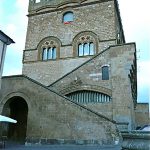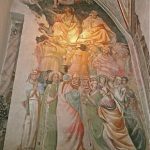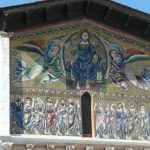[DFP2025] F. Aparicio: On the Jordan-Brouwer theorem.
Abstract: The aim of this work is to provide an elementary proof of the classical
version of the Jordan-Brouwer separation theorem, which can be stated as follows:
every boundaryless smooth hypersurface closed in an affine space disconnects it. The inverse function theorem implies that this separation holds locally, and we will extend the
separation to the whole space using basic notions of point-set topology and a simple
result about bipartite graphs. Later on, we will interpret this proof in the context
of transversality theory, construct global equations for these hypersurfaces from the
obtained division of the space, and analyze a large family of topological spaces where
a more general version of the Jordan-Brouwer separation theorem holds using
Cech cohomology.
Keywords: Separation, division, bipartite graph, global , transversalidad, orientabilidad.
MSC: 55M25, 55P57,55Q40,57N05, 57N50.
[DFP2024] N. Averna: Introduction to Morse theory.
Abstract: The aim of this work is to introduce the fundamentals of Morse theory, from the definition of Morse functions, their abundance, and their local form, to the two essential theorems, which describe the topological type of a compact manifold between and through critical values of a Morse function. These tools describe the topological type of any compact manifold using Morse functions and, in particular, give the classification of orientable compact surfaces. Finally we deduce the Poincaré-Hopf theorem for Morse functions and use it to compute the Euler characteristic of some differentiable manifolds.
Keywords: Morse function, critical value, index, Morse lemma, topological type, Poincaré-Hopf theorem, Euler characteristic.
MSC: 57R19, 57R20, 55R25, 57R70.
[DFP2024] S. Luque: Introduction to the Hopf invariant theory.
Abstract: In this work, we study the rudiments of the Hopf invariant theory. First, we present several relevant results on the theory of smooth manifolds: regularity, approximation, homotopy, integration, and cohomology. Next, we define the Brouwer-Kronecker degree of a continuous map using the de Rham cohomology and approximation, and study some of its properties. Later, we do the same for the Hopf invariant, and prove, with this definition, that it is an integer. We also present its definition using the linking number of two fibers. With these tools, we study the cohomotopy groups of manifolds, and, in particular, the homotopy groups of spheres, ultimately proving Hopf’s theorem: the degree is the only homotopy invariant of continuous maps on spheres. From there, we proceed to study the results where the Hopf invariant is relevant, which leads us to Hopf fibrations. We explicitly calculate the Hopf invariant of the complex Hopf fibration and we conclude our work seeing how it induces isomorphisms between the homotopy groups of the involved spheres.
Keywords: Smooth manifolds, Brouwer-Kronecker degree, Hopf invariant, linking number, homotopy groups, Hopf theorem, Hopf fibrations.
MSC: 55M25, 55Q25, 55Q40, 55R05.
[DFP2022] D. Ruiz: The de Rham theorem.
Abstract: The aim of this work is to provide a complete and self-contained proof of the de Rham theorem, which can be stated as follows: de Rham cohomology is equivalent to singular cohomology with real coefficients. To this end, we shall make use of various tools from different areas such as homological algebra, algebraic topology and differential topology – cochain complexes, the Mayer-Vietoris sequence or cohomology groups on a manifold– to finally establish the main result in the most direct and explicit way possible.
Keywords: Cohomology, cochain complexes, induction on open sets, Mayer-Vietoris, singular homology, smooth singular homology, de Rham.
MSC: 57R19, 58A05, 58A12.
[DFP2022] V. Álvarez: The Poincaré-Hopf theorem.
Abstract: In this work we study the Poincaré-Hopf Index Theorem. Firstly, we present several relevant results regarding the approximation and homotopy of proper mappings. Then, we define the Brouwer-Kronecker degree using the de Rham cohomology, and we prove the very significant Boundary Theorem. Furthermore, we study the singularities of vector fields, in particular non-degenerate ones, which lead to the notion of index of a vector field. We then prove the Poincaré-Hopf Index Theorem and we study in more detail gradient fields, in particular those of Morse functions. Finally, we make the link with the Euler characteristic and the Gauss-Bonnet Theorem.
Keywords: approximation, homotopy, proper mapping, de Rahm cohomology, Brouwer-Kronecker degree, index of a tangent vector field, Poincaré-Hopf theorem, Morse function, Euler characteristic, Gauss-Bonnet Theorem.
MSC: 57R19, 57N65, 58A05, 57R45, 37C99.
[MFP2022] A. Calleja: Homotopy of mappings for real projective spaces.
Abstract: The goal of this work is to classify through the degree the homotopy types of continuous maps into real projective spaces with domain the sphere (of the same dimension) or the given projective space. To that end, we will study the liftings of this maps to the universal covering (another sphere) and the homotopies between them, as well as the conditions that these homotopies must satisfy to give rise to homotopies between the original maps. A really helpful tool for this end will be the Brouwer- Hopf Theorem, which classifies the homotopy type of continuous maps from a compact manifold to the sphere. In the last sections we study the functoriality on the domain and make the comparison wirh homotopy groups.
Keywords: Degree, even/odd homotopy, Brouwer-Hopf Theorem, covering spaces, homotopy lifting, real projective space, homotopy type.
MSC: 55P15, 55M30.
[DFP2021] R. Casado: De Rham Cohomology: The Hopf fibrations.
Abstract: We carry out a detailed study of the de Rham cohomology, including the Mayer-Vietoris sequence, up to formulate the Poincaré duality. We take special care to prove Poincaré’s Lemma and its equivalent version for the compact support case. With these tools we calculate the cohomology of some significant concrete spaces, like spheres. From there we define the Hopf invariant for a differentiable function between spheres, which detects that these fibrations are essential. We conclude proving this as a consequence of the homotopy lifting theorem and the Ehresmann theorem for proper submersions.
Keywords: de Rham cohomology, Poincaré’s Lemma, Mayer-Vietoris sequence, Hopf invariant, Hopf fibration, homotopy lifting, Ehresmann theorem, proper submersion.
MSC: 57R19, 57N65, 58A05, 55P05, 55R10.
[DFP2021] P. Cordero: De Rham Cohomology: The Poincaré duality.
Abstract: We study the de Rham cohomology on smooth manifolds. We prove the Mayer-Vietoris theorem, the topological invariance of the de Rham cohomology groups, the Poincaré duality for compact and non-compact support, and the Künneth theorem, which explores the cohomology of the product of two manifolds. As applications, we compute the cohomology groups of several manifolds, as well as the top cohomology group and the degree 1 group in the general case. Besides, we prove the Jordan-Brouwer theorem and study some properties of the Euler characteristic.
Keywords: differential form, exact form, closed form, cochain, de Rham cohomology, Mayer-Vietoris, duality, Künneth, Jordan-Brouwer theorem.
MSC: 57R19, 57N65, 58A05.
[DFP2021] J. González: De Rham cohomology: The Poincaré-Hopf theorem.
Abstract: We introduce cohomology’s basic concepts and results, as to be applied to the de Rham cohomology. First non-compact support theory is developed, then with compact support. Afterwards we study the required theory about degree and Morse functions to be able to state and prove the Poincaré-Hopf theorem for Morse functions. We will also include a nice topological application of degree theory. Then we prove the Gauss-Bonnet theorem using a result from Morse theory. Finally we prove the Reeb theorem which gives a topological characterization of spheres through Morse functions.
Keywords: de Rham cohomology, Poincaré operator, Mayer-Vietoris sequence, degree theory, Morse function, gradient-like vector field, Poincaré-Hopf theorem, Gauss-Bonnet theorem, Reeb theorem.
MSC: 57R19, 57N65, 58A05, 57R45, 37C99.
[DFP2020] A. Rodríguez: The Schoenflies theorem for the torus.
Abstract: We study the Jordan-Schoenflies theorem for the torus, which classifies Jordan curves on the torus modulo ambient homeomorphism depending on whether they disconnect the torus or they do not. We show that there are two types of curves: those that are nullhomotopic, which disconnect the torus; and the rest, which do not. Besides, the complements of two curves of the same type are homeomorphic: to an annulus for those which do not disconnect, and to a disk and a punctured torus for those which do. Furthermore, we study which ambient homeomorphisms can be refined to isotopies.
Keywords: Jordan curves, polygonal, Jordan-Schoenflies theorem, torus, covering, lifting, homotopy, fundamental group, isotopy.
MSC: 57N05, 57N50.
[DFP2020] J. Polo: Brouwer-Kronecker degree theory.
Abstract: In this work we study the basics of Bouwer-Kronecker degree theory. In order to define consistently the degree of a smooth mapping and its extension to continuous mappings, we prove results regarding the existence of diffeotopies and approximation/homotopy of (proper) continuous mappings. The homotopy invariance of the degree is applied in order to tackle some deep topological theorems as the Borsuk-Hirsch theorem addressing the degree of even and odd mappings in spheres and the Jordan-Brouwer theorem on the separation of affine spaces by hypersurfaces.
Keywords: Orientation, diffeotopy, approximation, proper mapping, degree, spheres, essential mapping, parity.
MSC: 55M25, 55P57,55Q40.
[DFP2019] P. Esteban: De Rham cohomology and Brouwer-Kronecker degree.
Abstract: In this work we study some aspects of the de Rham cohomology. We will introduce the Lie derivative and inner product and we will explore the integration of top degree cohomology classes, showing that it is an isomorphism. We will also prove the Poincaré lemma, linking cohomology to homotopy. In the end, we will present the Brouwer-Kronecker degree and use the previous tools to prove some important theorems: Brouwer’s fixed point, invariance of domain, and Hopf’s on homotopy of mappings of spheres.
Keywords: Differential form, Lie derivative, exterior derivative, cohomology group, integration of cohomology classes, degree, homotopy.
MSC: 57R35, 58A12, 55M25, 55Q40, 55Q25.
[DFP2019] A. Martín: The Gauss-Bonnet Theorem.
Abstract: In this work we study in full the proof of the Gauss-Bonnet theorem. The notions of differential geometry of curves and surfaces involved are reminded (curvatures and integral), and more advanced tools as the Umlaufsatz and differentiable triangulations of surfaces are shown in detail. The goal is to include details mostly assumed without explanation in texts on the matter.
Keywords: First fundamental form, Gaussian curvature, compact surfaces, winding number, Umlaufsatz, differentiable triangulations, geodesic curvature, curvatura integra.
MSC: 53A05, 53B20, 53C22, 55M25.
[DFP2018] G. Gallego: Introduction to symplectic geometry and integrable systems.
Abstract: The main goal of this work is to prove the Arnold-Liouville theorem, which gives a sufficient condition for a Hamiltonian mechanical system to be integrable by quadratures. To that end we define and develop the concepts involved in the theorem, giving some elementary notions of symplectic geometry and its application to Classical Mechanics.
Keywords: Symplectic geometry, integrable systems, Arnold-Liouville theorem, hamiltonian flows, Hamilton equations, Lie derivative, time-dependent vector fields.
MSC: 37J05, 37J35, 53D05, 58A05, 70H05.
[DFP2018] M. Jaenada: The Schoenflies theorem.
Abstract: In this work we will prove the Schoenflies Theorem. We will introduce first the Jordan curve theorem and some variations; this is at the basis of Schoenflies theorem. Then we will prove the Shoenflies theorem in the polygonal case, and produce a polygonal approximation of any Jordan curve, which will give way to the final step of the proof. As an application we will study the theorem in the (real) projective plane, that shows how Jordan-Schoenflies fails in compact surfaces other than the sphere, and provides a criterion to distinguish Jordan curves.
Keywords: Jordan curve, Jordan theorem, polygonal Jordan curve, linear accessibility, polygonal approximation, Schoenflies theorem, fundamental group, (real) projective plane, Jordan curves in the projective plane.
MSC: 57N05, 57N50.
[DFP2017] M.A. Berbel: The real symplectic group.
Abstract: In this work we study the real symplectic group consisting of linear endomorphisms that preserve an antisymmetric bilinear form. A basic algebraic approach shows that its special group is the whole group and provides generators known as symplectic transvections. From the geometric viewpoint we see that the symplectic group is a Lie group to which a Lie algebra can be associated. Its orthogonal subgroup is a compact Lie subgroup isomorphic to the unitary group and, furthermore, it is a deformation retract of the symplectic group. Analytical tools such as the exponential mapping, the logarithm and real powers of definite positive symmetric matrices are developed in the process.
Keywords: Symplectic group, transvection, Lie group, orthogonal subgroup, exponential mapping, real powers of matrices.
MSC: 15A16, 15A60, 22E15, 22E60, 51A50.
[DFP2016] A. Alonso: The topology of division problems: envy-free fair division and consensus division.
Abstract: We study two division problems and the topology behind their solutions. The problems are fair division and consensus division, and the topological results involved are the Brouwer Fixed Point Theorem and the Borsuk-Ulam Theorem. These theorems are deduced from their discrete versions: the Sperner Lemma and the Tucker Lemma. In fact, we prove a generalization of the latter: a weak versión of the Ky Fan lemma. The proofs involve the use of suitable graphs associated to polyhedra. Also we discuss the formal equivalences among all these results.
Keywords: Envy-free fair division, consensus division, Sperner’s lemma, Brouwer’s fixed point theorem, weak Ky Fan’s lemma, Tucker’s lemma, Borsuk-Ulam’s theorem.
MSC: 52B11, 55M20, 55M25, 91A12, 91B02.
[DFP2016] F. Coltraro: The Poincaré-Hopf theorem.
Abstract: We explore the relationships between functions —vector fields and real functions— defined on smooth manifolds and the topology of the manifolds themselves. We will mostly use tools from Differential Topology. Main results are the Poincaré-Hopf Index Theorem and the Gauss-Bonnet formula for hypersurfaces of even dimension. Basically both results show that certain geometrical quantities —the total index of a vector field and the integral curvature— are invariants of the manifolds where they are defined. In order to obtain these theorems our main tool will be the Brouwer-Kronecker topological degree; with it we will be able to define the key notion of this article: the index of a vector field at an isolated singularity. Along the way we will also give a short introduction to Morse Theory, which in turn allows us to prove the Reeb Theorem. Finally, we study under which hypothesis we can be certain that non-zero vector fields defined on manifolds exist.
Keywords: Differential topology, topological degree, index of a vector field, Morse theory, non-zero vector fields, Poincaré-Hopf theorem, Gauss-Bonnet formula.
MSC: 57R19, 57R25, 54C20.
[DFP2015] E. Fernández: Paracompactness and metrization.
Abstract: The aim of this report is to study the notions of Point Set Topology stated in the title. The topology of metric spaces is an important topic in different fields: differential topology, riemmanian geometry and Banach spaces, among others. The study of the metrization problem inherently entails an in-depth study of the concepts of normality and paracompactness. One of its most remarkable applications is the construction of continuous special functions (Urysohn functions, partitions of unity) which allow a better treatment of the topological properties of spaces. Among other results proved here we single out E. Michael’s characterizations of paracompactess and Bing and Nagata-Smirnov metrization theorems; also Dugundji-Borsuk and Rudin theorems on mappings into locally convex real topological vector spaces.
Keywords: Metrization, normality, paracompactness, Stone theorem, Bing metrization theorem, Nagata-Smirnov metrization theorem, partition of unity.
MSC: 54D15, 54D20, 54E35, 54E30.
[DFP2015] J. Porras: The Jordan curve theorem and planar graphs.
Abstract: The author studies the Jordan curve theorem, with special emphasis on some aspects connected with Graph Theory, namely planarity. He explains how the famous non-planar graphs K5 and K3,3 contain a relevant part of the topological essence of the Jordan Theorem. This is half of the famous Kuratowski theorem, the other half is that those graphs are the minimal non-planar examples. There, he discusses carefully the usually understated constructions behind the proof of that second half, providing rigurous arguments for some facts that are usually taken for granted. In particular, extreme care is given to the topological properties of plane graphs with polygonal edges, their faces and the boundaries of the latter.
Keywords: Jordan curve theorem, Brouwer fixed point theorem, planar graph, complete graph K5, complete bipartite graph K3,3, Kuratowski theorem.
MSC: 05C10, 57M15, 57N05.
[DFP2015] F. Criado: Azimuth: design and development of a non-euclidean video game.
Main Tutor: Marco Antonio Gómez.
Abstract: The author proposes a uniparametric algebraic model of hyperbolic, euclidean and elliptic geometries considering the real curvature k as the parameter. This will express the intuition that these models are similar for small values of |k|. He studies with detail the geometric invariants of the models: first fundamental form, curvature, geodesics and parallel transport. Then, the model is applied to define some polyhedral surfaces, an extended notion of geodesics in them and some computationally efficient methods for their simulation involving computations of geodesic distances.
Keywords: Differential geometry, non-euclidean geometry, video game development, Unity, computational geometry, computer graphics.
MSC: 53A05, 53A35, 53B20, 53C23.
CCS: Geometric topology, Computational geometry, Algorithmic game theory, Software design engineering.
[DFP2015] M. Pulido: Singular homology.
Abstract: The author gives a direct and selfcontained presentation of Singular Homology: construction, relative homology, exact sequences, Mayer-Vietoris. Then, he applies it to deduce some important classical results as the Brouwer fixed point theorem, local invariance of dimension and invariance of domain, or the Jordan-Brouwer separation theorem. He also compares Singular Homology with Simplicial Homology. He briefly introduces the notion of mapping degree, presenting its main properties and using them to prove the Brouwer hairy ball theorem. As a final point, he presents a generalization of the Jordan-Brouwer theorem that explains the difference between homology and homotopy: the Alexander horned sphere shows that Schoenflies theorem fails in dimension bigger than 2, but the failure is homotopic, not homologic.
Keywords: Singular homology, exact sequence of a pair, Mayer-Vietoris, degree, invariance theorems, Brouwer theorems.
MSC: 55N10, 57N65, 55Q99, 55M25.
[DFP2013] I. González: The Brouwer-Kronecker degree.
Abstract: The author studies the Brouwer-Kronecker degree, using de Rham cohomology and integration of forms on manifolds. Two first important applications are: the fixed point theorem and the so-called hairy ball theorem, both due to Brouwer. But the main motivation are the homotopy groups of spheres. These homotopy groups are all trivial for order smaller than dimension, as is explained by using the Sard-Brown theorem. For order equal to dimension the Brouwer-Kronecker degree gives the solution: the group is cyclic infinite, a famous theorem by Hopf which is the central result here. For order bigger than dimension the situation becomes much more complicated, except the case of the circle (all homotopy trivial for order bigger that 1, the proof of which is included for completeness). Still, degree gives a method to understand something more through the Hopf invariant. After defining this invariant and obtaining its basic properties, the author computes the Hopf invariant of the famous Hopf fibration, to conclude that the third homotopy group of the 2-sphere is infinite.
Keywords: Homotopy groups, de Rham cohomology, Brouwer-Kronecker degree, Hopf invariant, Hopf fibration.
MSC: 57R19, 57R35, 58A12.
[DFP2013] J.A. Rojo: Approximation and homotopy.
Abstract: In this paper the author deals with differentiable aproximation and homotopy of continuous and proper mappings whose target is a manifold with boundary. The initial motivation is the direct computation by differentiable methods of the de Rham cohomology (with or without compact supports) for such a manifold, as is usually done for boundaryless manifolds. When there is no boundary, tubular neighborhoods and differentiable retractions are the key tool, but as is well known, there cannot be differentiable retracts in the presence of a boundary. To amend this requires a careful examination of the construction of collars in manifolds with boundary, which will provide the means to find differentiable pseudoretracts. In addition, one must embed any given manifold with boundary into a boundaryless manifold of the same dimension. This is easy up to diffeomorphism, but it is achieved here without any modification of either the manifold or the ambiente space.
Keywords: Boundary, approximation of mappings, homotopy, tubular neighborhood, retraction, collar, pseudoretraction.
MSC: 57R19, 57R35, 58A12.
[PhD2001] J.F. Fernando: Sums of squares in surface germs.
Abstract: The author shows first that the Pythagoras number of a real analytic surface germ is finite, bounded by a function of its multiplicity and its codimension. This he gets by solving a question concerning Pythagoras numbers of finitely generated modules over power series and polynomials in two variables. Secondly, he completes the full classification in 3-space of surface germs on which every positive semidefinite analytic germ is a sum of squares of analytic germs (in fact, he shows, of two squares). He also finds examples of not embedded surface germs with that property.
Keywords: Positive semidefinite germ, sum of squares, analytic germ.
MSC: 14P20, 32S10.
Papers:
J.F. Fernando: On the Pythagoras number of real analytic rings. J. Algebra 243 (2001) 321-338.
J.F. Fernando, J.M. Ruiz: Positive semidefinite germs on the cone. Pacific J. Math. 205 (2002) 109-118.
J.F. Fernando: Positive semidefinite germs in real analytic surfaces. Math. Ann. 322 (2002) 49-67.
[PhD2000] J. Escribano: Definable triviality of families of definable mappings in o-minimal structures. Main advisor: M. Coste.
Abstract: The author shows the triviality of pairs of proper submersions in any o-minimal structure expanding a real closed field. This means not only that the involved submersions are definable, but most important that the trivialization is definable too. This requires the use of the definable spectrum in a essential way to solve the lack of integration means. The author proves previously a basic result: an approximation theorem for definable differentiable maps, which has interest by itself and implies other interesting applications (smoothing of corners, for instance). He finally obtains a nice application concerning the definable triviality off bifurcation sets.
Keywords: Triviality of submersions, definable approximation, definable spectrum.
MSC: 14P20, 03C68, 57R12.
Papers:
J. Escribano: Nash triviality in families of Nash mappings. Ann. Inst. Fourier 51 (2001) 1209-1228.
J. Escribano: Bifurcation sets of definable functions in o-minimal structures. Proc. AMS 130 (2002) 2419-2424.
J. Escribano: Approximation theorems in o-minimal structures. Illinois J. Math. 46 (2002) 111-128.
[PhD1994] P. Vélez: The geometry of fans in dimension 2.
Abstract: The author finds a geometric criterion for basicness of semialgebraic sets in algebraic surfaces. This involves separation and approximation, and the description of two types of obstructions: local and global. Since these geometric ideas are connected to the algebraic notion of fan, it is essential to know well the theory of fans in a surface, which is achieved by means of generalized Puiseux expansions. Finally, both the geometric and the algebraic views are mixed to produce an algorithm that checks basicness, and exhibits a fan obstruction if there is any.
Keywords: Basic semialgebraic set, fan, separation.
MSC: 14P10, 13A18.
Papers:
F. Acquistapace, F. Broglia, P. Vélez: An algorithmic criterion for basicness in dimension 2. Manuscripta Math. 85 (1995) 45-66.
P. Vélez: On fans in real surfaces. J. Pure Appl. Algebra 136 (1999) 285-296.
[PhD1986] J. Ortega: Pythagoras numbers of a real irreducible algebroid curves.
Abstract: The author studies the Pythagoras number of a real irreducible algebroid curve in terms of its value semigroup. Fixed a semigroup, he describes explicitely an algebraic set parametrizing all curves with that semigroup of values. Then, the Pythagoras number defines a partition of that set into finitely many semialgebraic sets which involves algorithmic (upper and lower) bounds for the Pythagoras number. An application of this is the determination of Pythagorean curves. Other matters discussed are semicontinuity of the Pythagoras number, Hilbert’s 17th Problem, and change of ground field.
Keywords: Pythagoras number, value semigroup.
MSC: 14P15, 32B10.
Paper:
J. Ortega: On the Pythagoras number of a real algebroid irreducible curve. Math. Ann. 289 (1991) 111-123.






































